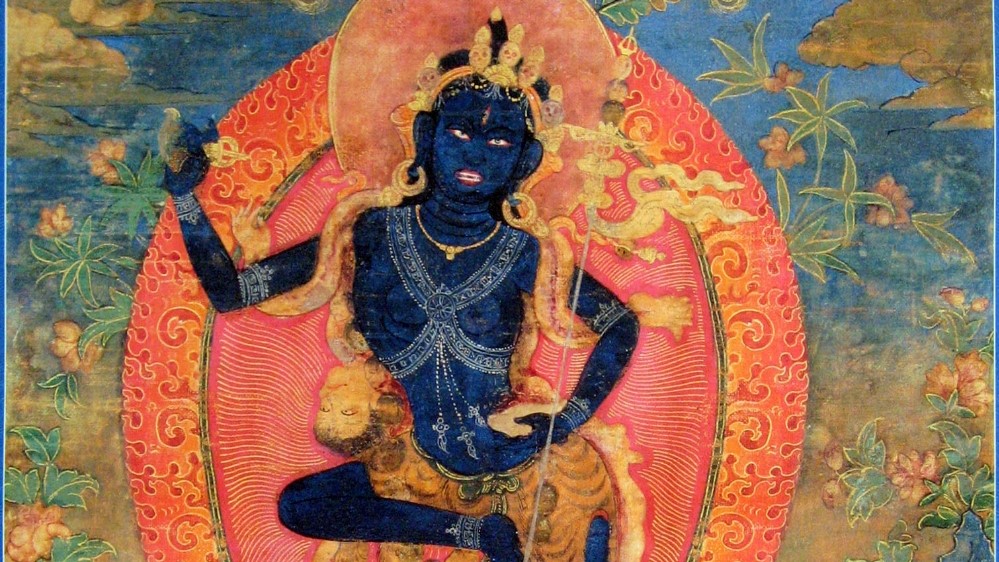Nairatmya is a Vajrayana goddess who embodies the supreme Buddhahood. Her main role is as a wife of the Tantric meditational deity (Tib. yidam) Hevajra, but she also has an independent significance as a supreme dakini. Her Sanskrit name, as well as its Tibetan version, Dagmema, translates as “the one who realized the absence of the self.” She is a physical embodiment of the basic Buddhist idea of lack of independent self (Tib. gangzag dagme) and lack of self of phenomena (Tib. cho kyi dagme). This notion is associated with the concept of emptiness (Tib. tongpa nyi), incarnated in the figure of the Mahayana goddess Prajnaparamita. Thus, Nairatmya can be considered as a Tantric version of the goddess of perfect wisdom.

The concept of emptiness is associated with the idea that phenomena do not have a real existence, but an illusory manifestation, conditioned by the principle of interdependance (Tib. tendrel) of all phenomena. The purpose of Nairatmya as yidam is to replace the notion of the limited self with a visual image of emptiness that helps to dispel the suffering caused by clinging to illusory objects. Removing this fundamental ignorance leads to freedom and great bliss.
Nairamya is also perceived as a “yogini of supreme bliss” (Skt. mahāsukhā divyayoginī) and a “source of spontaneous bliss” (Skt. sahajānandakariṇī). The bliss is spontaneous because it occurs naturally when the delusions that cause suffering are removed. It is also beyond the duality of object and subject and characterizes the nature of the mind. The goddess is associated with the perception of ultimate reality (Skt. dharmadhātu svabhāva), which is described in the Hevajra Tantra as the fusion of emptiness and bliss.

Nairatmya is defined as the supreme goddess (Skt. mahādevī), a manifestation of the original feminine energy (Skt. ādiśakti) and dakini, which “flies in space” (Skt. khecarī). She is also an embodiment of the five enlightened wisdoms and their corresponding Dhyani Buddhas. Above all, she is connected with the Vajra family of Akshobhya and the transformation of anger into mirror-like wisdom. His color is blue just like the color of Nairatmya. The blue color of the goddess symbolizes emptiness and infinite space, which reflects her boundless wisdom. She has the attributes of dakinis, including the five bone ornaments that symbolize the five Dhyani Buddhas. They express the idea that she is revered as a perfect Buddha who has attained the five wisdoms.
The most popular image of Nairatmya is in a dancing position. In her right hand she holds a curved knife that cuts negative thoughts, and in her left hand a kapala which substance transforms illusions. In her left hand she also holds a scepter, symbolizing her husband Hevajra. Sometimes she is depicted in a sitting position with her right leg bent and her left leg straight, holding the same attributes. There are also images of her with four hands, in which she holds a curved knife and vajra in the right and a kapala and a scepter in the left. In these cases, her body is in a dancing position and her face in a wrathful expression. In her single forms, she is stepping on a corpse that symbolizes the victory over the selfish mind.
Nairatmya is often depicted in union with Hevajra, who is also blue in color, with two, four, six, or sixteen hands. The form of Hevajra with sixteen hands is standing, with eight heads and four legs. In each of his hands he holds a kapala with different images. The two figures, depicted in union (yab yum) stepped on four demons: yellow Brahma, black Vishnu, white Shiva, and yellow Indra. In an image of the Kagyu School around both figures, the eight wrathful goddesses can be seen, with Marpa, Milarepa and Gampopa above them and Palden Lhamo below them.

